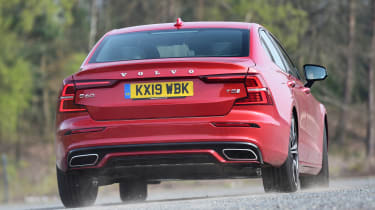Volvo S60 saloon - Engines, drive & performance
S60 is quick and secure but can't beat rivals for driving pleasure
The Volvo S60 Recharge T8 version offers, on paper, more than just a rivalry with plug-in hybrid versions of the Mercedes C-Class and BMW 3 Series saloon when it comes to performance; in terms of sheer acceleration, the T8 is up there with the most powerful models in each range.
The rear-wheel BMW 3 Series is broadly regarded as the enthusiasts' choice in its class, thanks to its sharp, responsive feel. By contrast, the S60 B5 petrol and plug-in hybrid are nominally front-wheel-drive (like an Audi A4), with the electric motor providing additional power to the rear wheels when necessary in the hybrids. However, the rear wheels never receive as much power as those at the front.
When we drove the S60 Recharge T8, we found that its setup doesn’t achieve quite the same sense of balance and poise as the BMW – or to a lesser extent, the Mercedes C-Class. The steering is accurate and confidence-inspiring, and the suspension does a good job of keeping the car flat, but push it hard enough and the S60 is prone to understeer.
Lifting off the accelerator allows the car to regain its composure, and doing this doesn’t cause oversteer in corners like it might in a rear-wheel drive car. That's partially thanks to the impressive amount of grip the S60's big tyres have to offer and partly thanks to the traction provided by the electric motor on the rear axle.
More reviews
In-depth reviews
The plug-in hybrid's batteries and electric motor add an extra 200kg of weight compared to a petrol S60, which necessitates a firm suspension setup to keep body lean at bay. The petrol S60 B5 rides more softly but doesn’t corner any worse.
For those who want the sportiest S60 possible, Volvo used to offer a Polestar Engineered version of the plug-in hybrid. It has an even stiffer ride thanks to dampers from Swedish performance experts Ohlins, of motorsport fame. There's more stopping power, too, thanks to Brembo brakes.
Changes for the Polestar version don't quite gel with the Recharge setup like you might hope – it's incredibly fast (0-62mph takes just 4.2 seconds), but the engine doesn't sound particularly good or have the exciting character of the BMW or Mercedes. The suspension is also too stiff in its factory setup, and while you can adjust it manually, doing so requires lifting the bonnet to access the front dampers and jacking the car up to turn the dial on the rears - something we doubt many owners will do.
Volvo S60 petrol engine
The S60 B5 has a 2.0-litre turbocharged petrol engine producing 247bhp, paired with a standard eight-speed automatic gearbox. It gets the Swedish saloon from 0-62mph in 6.7 seconds but it’s still not especially sporty. The car is quiet at lower revs and the gearbox shuffles through changes to help the car build speed, but take manual control and hold onto more revs and it sounds harsh, and the shifts aren’t particularly satisfying.
Plug-in hybrid engines
The Recharge T8 plug-in hybrid model uses a combination of four-cylinder petrol engine, electric motor and lithium-ion battery pack. It uses a 2.0-litre engine that's turbocharged and supercharged, producing 306bhp on its own. All that power goes to the front wheels, while the electric motor produces a further 145bhp that's sent to the rear wheels. There's effectively 449bhp in total.
Volvo claims 0-62mph in 4.6 seconds, and while the S60 T8 doesn't quite feel as quick in the real world as that figure suggests, there's no doubting its impressive turn of speed on a twisting country lane. Interestingly, despite being so similar, the Volvo V60 estate gets a different hybrid powertrain, with 345bhp instead of the S60’s huge 449bhp output.
As mentioned above, the S60 Polestar Engineered pack didn’t turn the car into a sports car and felt like a motoring novelty compared with rivals. The all-electric BMW i4 feels more involving and exciting, while the S60's steering isn't as tactile as that found in the Mercedes C 300 e.










